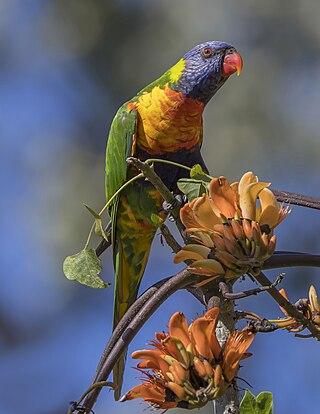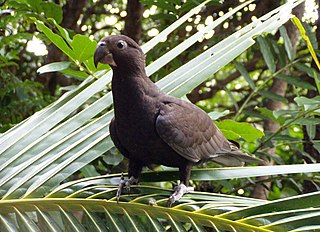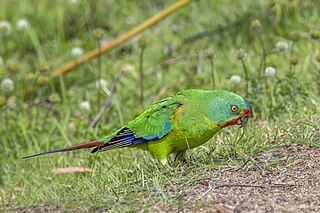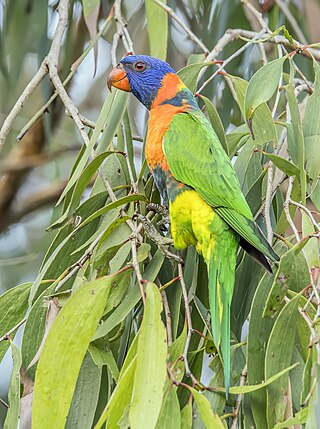
A cockatoo is any of the 21 species of parrots belonging to the family Cacatuidae, the only family in the superfamily Cacatuoidea. Along with the Psittacoidea and the Strigopoidea, they make up the order Psittaciformes. The family has a mainly Australasian distribution, ranging from the Philippines and the eastern Indonesian islands of Wallacea to New Guinea, the Solomon Islands and Australia.

The palm cockatoo, also known as the goliath cockatoo or great black cockatoo, is a large, smoky-grey/black parrot of the cockatoo family native to New Guinea, the Aru Islands and the Cape York Peninsula in Queensland, Australia. It has a crest of long feathers atop its head, with a very large and strong, sharply-hooked black beak, and prominent bright-red cheek patches.

The white cockatoo, also known as the umbrella cockatoo, is a medium-sized all-white cockatoo endemic to tropical rainforest on islands of Indonesia. When surprised, it extends a large and striking head crest, which has a semicircular shape. The wings and tail have a pale yellow or lemon color which is exposed when they fly. It is similar to other species of white cockatoo such as yellow-crested cockatoo, sulphur-crested cockatoo, and salmon-crested cockatoo, all of which have yellow, orange or pink crest feathers instead of white.

The crimson rosella is a parrot native to eastern and south eastern Australia which has been introduced to New Zealand and Norfolk Island. It is commonly found in, but not restricted to, mountain forests and gardens. The species as it now stands has subsumed two former separate species, the yellow rosella and the Adelaide rosella. Molecular studies show one of the three red-coloured races, P. e. nigrescens, is genetically more distinct.

The sulphur-crested cockatoo is a relatively large white cockatoo found in wooded habitats in Australia, New Guinea, and some of the islands of Indonesia. They can be locally very numerous, leading to them sometimes being considered pests. A highly intelligent bird, they are well known in aviculture, although they can be demanding pets.

The Moluccan eclectus is a parrot native to the Maluku Islands (Moluccas). It is unusual in the parrot family for its extreme sexual dimorphism of the colours of the plumage; the male having a mostly bright emerald green plumage and the female a mostly bright red and purple/blue plumage. Joseph Forshaw, in his book Parrots of the World, noted that the first European ornithologists to see eclectus parrots thought they were of two distinct species. Large populations of this parrot remain, and they are sometimes considered pests for eating fruit off trees. Some populations restricted to relatively small islands are comparably rare. Their bright feathers are also used by native tribespeople in New Guinea as decorations.

The rainbow lorikeet is a species of parrot found in Australia. It is common along the eastern seaboard, from northern Queensland to South Australia. Its habitat is rainforest, coastal bush and woodland areas. Six taxa traditionally listed as subspecies of the rainbow lorikeet are now treated as separate species.

The scarlet-chested parrot, known alternately as scarlet-breasted parrot, orange-throated parrot or splendid parrot, is a parrot endemic to central South Australia and inland southern Western Australia. The species is sexually dimorphic; the male has a bright blue face and scarlet chest and yellow underparts, amid overall green plumage, while the female is similar but lacks the red chest. These nomadic parakeets move readily from the Great Victoria Desert region into neighbouring areas. These interruptions are triggered by a search for more favourable conditions. They can survive quite well without access to drinking water, however, as succulent plants help meet much of their fluid requirement. They feed mainly on grass seeds and are most commonly sighted in spinifex.

The greater vasa parrot is one of two species of vasa parrot, the other being the lesser vasa parrot. The greater vasa parrot can be found throughout Madagascar and the Comoros.

The swift parrot is a species of broad-tailed parrot, found only in southeastern Australia. The species breeds in Tasmania during the summer and migrates north to south eastern mainland Australia from Griffith-Warialda in New South Wales and west to Adelaide in the winter. It is a nomadic migrant, and it settles in an area only when there is food available. The Swift Parrot was voted 2023 Bird of the Year in The Guardian Australia and BirdLife Australia’s biennial poll.

The yellow-shouldered blackbird, known in Puerto Rican Spanish as mariquita de Puerto Rico or capitán, is a species of blackbird endemic to Puerto Rico. It has black plumage with a prominent yellow patch on the wing. Adult males and females are of similar appearance. The species is predominantly insectivorous.

The western corella also known as the western long-billed corella, is a species of white cockatoo endemic to south-western Australia.

The red-collared lorikeet is a species of parrot found in wooded habitats in northern Australia. It was previously considered a subspecies of the rainbow lorikeet, but today most major authorities consider them as separate species. No other member of the rainbow lorikeet group has an orange-red collar over the nape.

The ringed kingfisher is a large, conspicuous, and noisy kingfisher bird commonly found along the lower Rio Grande Valley in southeasternmost Texas in the United States through Central America to Tierra del Fuego in South America.

The crimson finch is a species of bird in the family Estrildidae. It is found throughout Northern Australia as well as parts of southern New Guinea. Crimson finches feature a distinctively bright crimson coat and are known for their aggression.

Finsch's pygmy parrot, also known as the emerald pygmy parrot and green pygmy parrot, is a member of parrot family Psittacidae inhabiting tropical rainforest regions of islands in Papua New Guinea, the Solomon Islands, and the Bismarck Archipelago.

The rufous owl, also known as the rufous boobook, is a species of owl in the family Strigidae. It was described in 1846 by John Gould, an English ornithologist. Its common name reflects the rufous-coloured feathers that these owls are covered with in adulthood. While it is uncommon, the species has a wide range, including Australia, Indonesia, and Papua New Guinea.

The Norfolk boobook, also known as the Norfolk Island boobook, Norfolk Island owl or Norfolk Island morepork, is a bird in the true owl family endemic to Norfolk Island, an Australian territory in the Tasman Sea between Australia and New Zealand. It is a subspecies of the morepork.

The Sumba eclectus, or Cornelia's eclectus is a parrot species which is native to Sumba. Also larger than the Moluccan eclectus, the male is a paler shade of green overall and has a bluer tail. The female has an all red plumage, except for the primaries which are a dark royal blue, and can be differentiated from the Tanimbar eclectus by the lack of yellow to her tail.

The Tanimbar eclectus, or Riedel's eclectus is a parrot species which is native to the Tanimbar Islands. It is smaller than the Moluccan eclectus. The male has a more bluish tinge to its green cheeks and neck, and its tail is edged with a broad band of yellow. The female has an all red plumage, except for royal blue primaries, yellow under-tail coverts and a broad band of yellow to edge the tail.



















